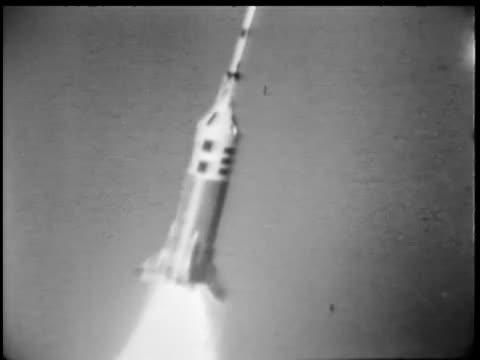Science Reporter; 58; Room at the Top
- Series
- Science Reporter
- Episode Number
- 58
- Episode
- Room at the Top
- Producing Organization
- United States. National Aeronautics and Space Administration
- WGBH Educational Foundation
- Contributing Organization
- Library of Congress (Washington, District of Columbia)
- AAPB ID
- cpb-aacip-512-jh3cz33429
- NOLA Code
- SRPT
If you have more information about this item than what is given here, or if you have concerns about this record, we want to know! Contact us, indicating the AAPB ID (cpb-aacip-512-jh3cz33429).
- Description
- Episode Description
- This episode focuses on the interior of the Apollo spaceship the equipment the astronauts will have and how they will be prepared for their in-flight environment. John Fitch is host on location at North American Aviation in Downey, California, and at the Manned Spacecraft Center in Houston. In about five years three astronauts will go on an eight-day, round-trip mission to the moon. From a few minutes after launch until the moment of touchdown, these men will be absolutely dependent on their small but complex spacecraft for power, shelter and other elements essential to maintain life. Milton Sherman, Assistant Program manager for Apollo at North American Aviation, shows reporter John Fitch full-scale engineering models of the Command and Service Modules, the Launch Escape System, and the Lunar Excursion Modules Adaptor. After a tour of the manufacturing facilities and assembly area, the problems of vehicle in-flight testing are explored. And finally, at the Manned Spacecraft Center in Houston, Texas, John Fitch shows viewers an Apollo Mission Simulator, where astronauts will undergo training for the lunar mission. Science Reporter: Room at the Top is a presentation of National Educational Television, produced by the National Aeronautics and Space Administration and by WGBH, Boston. (Description adapted from documents in the NET Microfiche)
- Series Description
- Science Reporter is a regularly recurring report on the latest development in all fields of science. It deals with everything from archaeology to space flight. Episodes were prepared at various locations throughout the country with special emphasis on the U.S. space program. The host is John T. Fitch, who was born in Shanghai. His father was YMCA Secretary in China. John entered this country in 1937 and a few years later enrolled at MIT. He volunteered for the Navy in 1944 and was discharged in China where he worked for the Armed Forces Radio Service. In Nanking, he built and operated his own radio station. He returned to the United States in 1949 and earned a degree in electrical engineering at MIT. While attending college, he was host for a number of radio jazz series and continued with WHDH until 1961. He was host for Science Reporter on WGBH-TV beginning in January of 1962. This series was originally recorded in black and white on videotape. (Description adapted from documents in the NET Microfiche)
- Broadcast Date
- 1966-06-26
- Asset type
- Episode
- Genres
- Talk Show
- Topics
- Technology
- Science
- Media type
- Moving Image
- Duration
- 00:29:11
- Credits
-
-
Director: Morash, Russell
Guest: Sherman, Milton
Host: Fitch, John T.
Producer: Morash, Russell
Producer: Fouser, Don
Producing Organization: United States. National Aeronautics and Space Administration
Producing Organization: WGBH Educational Foundation
- AAPB Contributor Holdings
-
Library of Congress
Identifier: cpb-aacip-4459f2e58a7 (Filename)
Format: 2 inch videotape
Generation: Master
-
Identifier: cpb-aacip-c090dd3e762 (unknown)
Format: video/mp4
Generation: Proxy
Duration: 00:29:11
If you have a copy of this asset and would like us to add it to our catalog, please contact us.
- Citations
- Chicago: “Science Reporter; 58; Room at the Top,” 1966-06-26, Library of Congress, American Archive of Public Broadcasting (GBH and the Library of Congress), Boston, MA and Washington, DC, accessed December 7, 2025, http://americanarchive.org/catalog/cpb-aacip-512-jh3cz33429.
- MLA: “Science Reporter; 58; Room at the Top.” 1966-06-26. Library of Congress, American Archive of Public Broadcasting (GBH and the Library of Congress), Boston, MA and Washington, DC. Web. December 7, 2025. <http://americanarchive.org/catalog/cpb-aacip-512-jh3cz33429>.
- APA: Science Reporter; 58; Room at the Top. Boston, MA: Library of Congress, American Archive of Public Broadcasting (GBH and the Library of Congress), Boston, MA and Washington, DC. Retrieved from http://americanarchive.org/catalog/cpb-aacip-512-jh3cz33429
